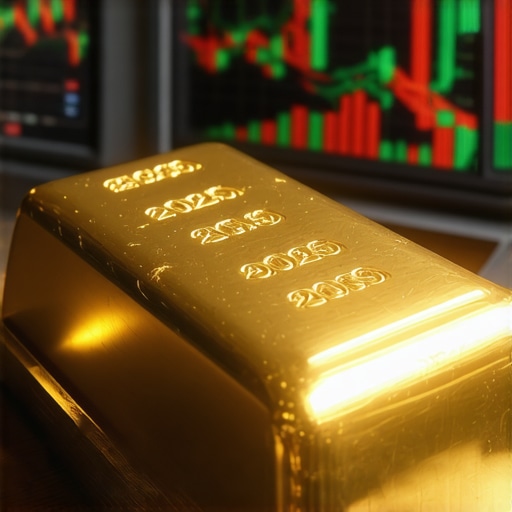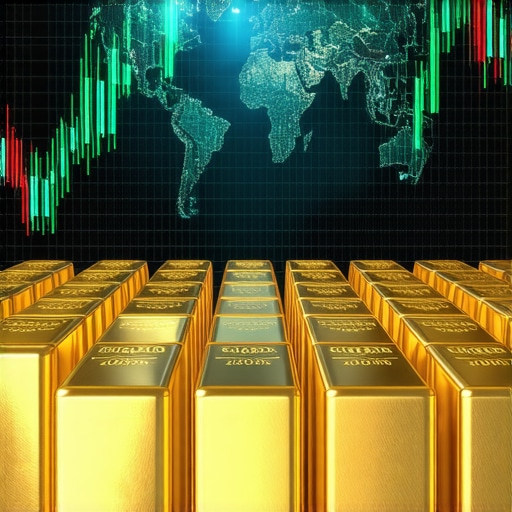Unraveling the Complex Web of Gold Market Forces in 2025
As we advance deeper into 2025, the gold market continues to be a focal point for investors, economists, and policymakers alike. Understanding the intricate interplay of factors influencing global gold supply and demand requires an expert lens that integrates geopolitical, economic, and technological dimensions. This comprehensive analysis explores the nuanced drivers shaping gold’s market dynamics, revealing insights essential for high-level investment strategies.
Macroeconomic Catalysts and Their Ripple Effects on Gold Demand
The persistent inflationary pressures and fluctuating interest rates across major economies are pivotal in driving demand for gold as a safe-haven asset. Central banks’ monetary policies, particularly those of the Federal Reserve and the European Central Bank, are instrumental in modulating gold’s appeal. For example, the recent shifts in quantitative easing measures have tightened liquidity, indirectly impacting physical gold acquisitions and futures trading volumes. Moreover, the role of gold as a hedge against currency devaluation remains prominent amid ongoing fiscal uncertainties.
How Are Global Supply Constraints and Mining Innovations Reshaping Gold Availability?
On the supply front, geopolitical tensions in resource-rich regions, coupled with regulatory reforms, have constrained mining operations. Notably, disruptions in countries like South Africa and Russia have tightened global output. However, advancements in extraction technology, such as automation and environmentally sustainable mining practices, are beginning to offset some supply bottlenecks by improving efficiency and reducing operational costs. This duality of supply limitation and technological innovation creates a complex supply landscape that demands close monitoring by market participants.
Investment Trends and Their Influence on Market Equilibrium
The diversification of gold investment vehicles, from physical bullion to Exchange-Traded Funds (ETFs) and gold futures, has broadened participation across both institutional and retail investors. The increasing preference for gold ETFs, which offer liquidity and lower transaction costs, is shifting demand patterns away from traditional physical holdings. This trend underscores the importance of understanding how financial instruments influence the gold market’s supply-demand balance, as fluctuations in ETF inflows can cause significant price volatility.
What Role Do Central Bank Gold Purchases Play in Shaping Demand Trends in 2025?
Central banks continue to be strategic actors in this market, with their gold purchasing decisions signaling confidence or caution in the global economy. The International Monetary Fund’s recent report highlights that central banks collectively increased their gold reserves by over 600 tonnes in 2024, emphasizing a strategic pivot towards gold amid geopolitical uncertainties. These acquisitions not only impact market liquidity but also serve as a benchmark for investor sentiment and long-term demand forecasts. Learn more about central bank gold buying’s influence on global demand.
CTA: Deepen Your Expertise with Advanced Gold Market Strategies
For professionals seeking to optimize their gold investment approach, exploring sophisticated allocation methods and understanding demand trends is crucial. Visit our detailed analysis on gold demand trends for smarter investment decisions in 2025 to enhance your strategic positioning in this evolving market.
Authoritative external reference: According to the World Gold Council’s 2025 Market Outlook, the balance between supply constraints and demand drivers will remain a defining characteristic of gold price movements this year (World Gold Council 2025 Outlook).
Technological Disruptions and Their Impact on Gold Market Liquidity
The integration of blockchain technology and digital gold platforms is revolutionizing how investors access and trade gold, amplifying market liquidity and transparency. These digital innovations facilitate fractional ownership and instantaneous settlement, reducing traditional barriers such as high transaction costs and physical storage concerns. Consequently, the gold market is experiencing increased participation from tech-savvy retail investors and institutional players seeking efficient portfolio diversification tools.
Moreover, the rise of tokenized gold assets is challenging the conventional dominance of physical gold and ETFs by offering seamless accessibility combined with regulatory compliance. This evolution necessitates a nuanced understanding of how digital gold intersects with traditional investment vehicles, influencing demand distribution and price discovery mechanisms.
How Can Investors Leverage Emerging Gold Investment Technologies for Portfolio Optimization?
Strategic incorporation of technological advancements in gold investment requires a blend of expertise in both finance and digital asset management. Investors must evaluate the credibility of digital platforms, the backing and liquidity of tokenized gold products, and the regulatory frameworks governing these instruments. Furthermore, balancing digital gold exposure with traditional holdings can enhance portfolio resilience, especially in volatile market environments.
For instance, combining physical gold bars, ETFs, and tokenized gold can provide diversified risk profiles and liquidity options. Investors should also remain vigilant about cybersecurity risks and counterparty reliability intrinsic to digital gold platforms.
Geopolitical Shifts and Their Subtle Influence on Gold Market Sentiment
Geopolitical developments in 2025 continue to cast a long shadow over gold market sentiment. Trade tensions, regional conflicts, and shifts in diplomatic alliances subtly modulate investor risk appetite, often triggering safe-haven buying or selling pressures. Notably, the recalibration of sanctions on major gold-producing nations affects both supply chains and investor confidence.
Additionally, evolving environmental and social governance (ESG) criteria are influencing mining company valuations and investor preferences. Sustainable mining practices and transparent reporting are becoming key differentiators, impacting demand for gold stocks and ETFs linked to responsible sourcing.
What Are the Implications of ESG Trends on Gold Mining Investments in 2025?
ESG considerations are reshaping the gold investment landscape by prioritizing companies demonstrating robust environmental stewardship, social responsibility, and governance standards. Investors increasingly incorporate ESG metrics when selecting gold stocks or funds, which can affect capital flows and valuations within the sector.
This shift presents both challenges and opportunities: companies lagging in ESG compliance may face divestment risks, whereas those pioneering sustainable mining innovations can attract premium valuations and long-term investor loyalty. Consequently, integrating ESG analysis into gold investment strategies is becoming a critical competency for sophisticated investors.
CTA: Enhance Your Gold Investment Strategy with Expert Insights
To navigate the complex interplay of technological innovation and ESG factors in gold investments, explore our comprehensive guides on building a diversified portfolio with gold ETFs and stocks and strategic gold investment techniques to grow wealth in uncertain times. Share your experiences or ask questions in the comments to join an expert community dedicated to mastering gold market intricacies.
Authoritative external reference: The World Gold Council underscores that technological innovation and ESG integration are transformative forces shaping gold demand and investment strategies in 2025 (World Gold Council Market Outlook 2025).
Decoding the Interplay Between Blockchain Innovation and Gold Market Fluidity
The gold market’s evolution is increasingly intertwined with blockchain technology’s disruptive capabilities. This nexus not only amplifies liquidity but also enhances transactional transparency and security — factors critical to institutional-grade investment. Blockchain-enabled platforms facilitate real-time auditing and provenance verification, addressing longstanding concerns about gold authenticity and ethical sourcing.
Moreover, the implementation of smart contracts automates settlement processes, drastically reducing counterparty risks and settlement delays that traditionally plagued gold trading. The ramifications ripple across market structure by enabling 24/7 trading windows and reducing reliance on physical vaulting.
How Does Blockchain-Backed Gold Trading Alter Risk Profiles for Institutional Investors?
Institutional investors must recalibrate risk assessments when integrating blockchain-backed gold assets. While the technology mitigates operational risks, it introduces new dimensions such as cybersecurity vulnerabilities and regulatory uncertainties. Furthermore, liquidity profiles differ significantly from conventional physical gold holdings due to tokenization’s fractionalization effects.
Strategically, blending tokenized gold with traditional bullion and ETFs can optimize portfolio liquidity and diversification, particularly in volatile macroeconomic environments. However, this requires rigorous due diligence on platform custodianship, underlying asset backing, and jurisdictional compliance frameworks.
Explore the World Gold Council’s detailed insights on tokenization and digital gold.
ESG Integration: The New Frontier in Gold Mining Valuation and Investment Strategy
Environmental, Social, and Governance (ESG) criteria have transitioned from peripheral considerations to central pillars in gold mining investment decisions. The sector is witnessing a paradigm shift as investors demand verifiable ESG credentials, compelling mining companies to innovate in sustainable extraction, community engagement, and transparent governance.
Recent data indicate that ESG-compliant mining operations often yield superior long-term returns and lower capital costs, reflecting reduced regulatory and reputational risks. Notably, firms leveraging renewable energy sources and implementing advanced waste management systems are garnering increased investor confidence.
What Quantitative Metrics Are Most Effective for Assessing ESG Impact on Gold Mining Profitability?
Quantitative ESG metrics, such as carbon intensity per ounce of gold produced, water usage efficiency, and social impact indices, offer granular insights into operational sustainability. These indicators, when integrated with traditional financial analysis, provide a multidimensional view of mining firms’ performance.
Advanced analytics, including machine learning models, are increasingly employed to predict ESG-driven valuation shifts and identify latent risks. Consequently, investors equipped with robust ESG evaluation frameworks can capitalize on emerging opportunities while mitigating exposure to ESG-related controversies.
CTA: Engage with Cutting-Edge Gold Market Analysis and ESG Investment Frameworks
To master the complexities of blockchain-enabled gold trading and ESG integration, delve into our expert resources tailored for advanced investors. Visit our comprehensive guide on advanced gold investment strategies and participate in our interactive forums to exchange insights with industry leaders.
Authoritative external reference: The World Gold Council emphasizes that blockchain-driven tokenization and stringent ESG standards represent transformative trends shaping gold investment paradigms in 2025 (World Gold Council Market Outlook 2025).
Deepening the Nexus of Blockchain and Gold Market Sophistication
The convergence of blockchain technology with gold trading platforms is not merely a novelty but a fundamental reshaping of market microstructure. Beyond liquidity enhancement, blockchain facilitates immutable provenance tracking, which is critical in assuring the ethical provenance of gold, a factor increasingly scrutinized by discerning investors. This capability underpins compliance with stringent regulatory regimes and bolsters investor trust.
How Do Smart Contracts and Tokenization Modify Regulatory and Compliance Frameworks in Gold Trading?
Smart contracts automate transactional workflows, embedding compliance checks and settlement conditions directly into the trade execution process. This automation reduces human error and accelerates settlement finality, yet simultaneously challenges existing regulatory paradigms that were designed for traditional, manual processes. Tokenization fractionalizes gold ownership, complicating jurisdictional oversight and requiring adaptive regulatory frameworks that balance innovation with investor protection.
Market participants must proactively engage with evolving regulatory landscapes, including Anti-Money Laundering (AML) and Know Your Customer (KYC) protocols tailored for digital assets. Institutional-grade custodianship solutions are emerging to mitigate these risks, providing secure digital wallets and insured storage mechanisms.
Quantitative ESG Analytics: Unlocking Predictive Power in Gold Mining Investments
Advanced quantitative ESG models now integrate satellite data, real-time emissions monitoring, and social sentiment analysis to generate predictive insights on mining company trajectories. These multifactor models enable investors to anticipate shifts in capital allocation driven by ESG performance, thereby optimizing entry and exit timing with greater precision.
Importantly, integrating ESG scores with traditional financial metrics via machine learning enhances risk-adjusted return profiles. For example, firms demonstrating lower carbon intensity and superior water stewardship statistically exhibit greater operational resilience and reduced regulatory penalties, factors that materially influence valuation multiples.
Portfolio Optimization: Synthesizing Traditional and Digital Gold Assets
Incorporating tokenized gold alongside physical bullion and ETFs introduces nuanced portfolio optimization opportunities. Tokenization enhances liquidity and allows granular exposure adjustments, enabling dynamic rebalancing in response to market volatilities. However, investors must balance these benefits against counterparty and technological risks inherent in digital platforms.
Sophisticated portfolio managers employ scenario analysis and stress testing to evaluate correlations among gold asset classes under varying macroeconomic shocks. This approach informs allocation strategies that hedge against systemic risks while capitalizing on the idiosyncratic advantages of each asset type.
Source: World Gold Council 2025 Market Outlook

CTA: Elevate Your Gold Investment Strategy with Cutting-Edge Technological and ESG Frameworks
Unlock the full potential of gold investment in 2025 by integrating blockchain innovations and predictive ESG analytics into your portfolio management. Explore our advanced resources and join an exclusive community of experts shaping the future of gold markets. Start mastering advanced gold investment strategies today.
Expert Insights & Advanced Considerations
Blockchain Integration Redefines Gold Market Transparency and Efficiency
The adoption of blockchain technology introduces an unprecedented level of transparency and efficiency in gold trading. By enabling immutable provenance tracking and real-time settlement via smart contracts, blockchain mitigates counterparty risks and enhances trust among institutional investors. Yet, this evolution demands a sophisticated understanding of cybersecurity protocols and regulatory compliance to fully capitalize on its benefits.
ESG Metrics Are Becoming Integral to Gold Investment Valuation
Environmental, Social, and Governance (ESG) factors no longer serve as peripheral indicators but have become pivotal in assessing gold mining companies’ long-term viability and profitability. Quantitative ESG analytics—such as carbon intensity and water usage efficiency—offer predictive insights that can materially influence investment decisions and capital allocation, rewarding firms with sustainable operational models.
Portfolio Diversification Benefits from Synthesizing Traditional and Digital Gold Assets
Incorporating tokenized gold alongside physical bullion and ETFs enables dynamic portfolio optimization, enhancing liquidity and risk management. This blended approach allows investors to fine-tune exposure with granular adjustments while navigating distinct risk profiles inherent to each asset class. Strategic balancing of these instruments is essential for resilience amid economic volatility.
Central Bank Gold Purchases Continue to Signal Macro-Economic Sentiment
Central banks’ ongoing accumulation of gold reserves reflects broader geopolitical and economic shifts, impacting market liquidity and investor confidence. Understanding these strategic moves provides critical context for anticipating demand trends and price movements, positioning investors to respond proactively to evolving global conditions.
Technological and Regulatory Innovation Requires Continuous Expert Vigilance
The rapid pace of innovation in digital gold trading platforms and evolving compliance frameworks necessitates vigilant due diligence. Investors must engage with emerging regulatory landscapes, including AML and KYC protocols tailored for digital assets, to safeguard investments and ensure alignment with best practices.
Curated Expert Resources
- World Gold Council Market Outlook 2025: A comprehensive resource detailing supply-demand dynamics, ESG integration, and blockchain-driven market transformations, essential for strategic investment planning (https://www.gold.org/goldhub/research/market-outlook-2025).
- BuyingGoldNow – Analyzing Gold Demand Trends for Smarter Investment Decisions in 2025: In-depth analysis on demand patterns and strategic approaches to optimize timing and portfolio allocation (https://buyingoldnow.com/analyzing-gold-demand-trends-for-smarter-investment-decisions-in-2025).
- BuyingGoldNow – How to Build a Diversified Portfolio with Gold ETFs and Stocks: Expert guidance on constructing balanced portfolios integrating various gold investment vehicles (https://buyingoldnow.com/how-to-build-a-diversified-portfolio-with-gold-etfs-and-stocks).
- BuyingGoldNow – Central Bank Gold Buying: Its Influence on Global Demand 2025: Insightful exploration of central banks’ strategic gold acquisitions and their market impact (https://buyingoldnow.com/central-bank-gold-buying-its-influence-on-global-demand-2025).
- BuyingGoldNow – Strategic Gold Investment Techniques to Grow Wealth in Uncertain Times: Practical strategies addressing economic volatility, ESG considerations, and technological disruptions (https://buyingoldnow.com/strategic-gold-investment-techniques-to-grow-wealth-in-uncertain-times).
Final Expert Perspective
The gold market in 2025 is characterized by a sophisticated convergence of technological innovation, ESG imperatives, and global geopolitical shifts. Blockchain-enabled trading platforms and tokenization are reshaping liquidity and transparency, while ESG analytics are redefining investment valuation frameworks. Central bank activities continue to act as bellwethers for market sentiment, influencing both demand and pricing dynamics. Mastery of these complex, interwoven factors is indispensable for any serious investor aiming to navigate the evolving landscape of gold investment successfully.
To deepen your expertise, engage actively with advanced resources like analyzing gold demand trends for smarter investment decisions and building a diversified portfolio with gold ETFs and stocks. Share your professional insights or questions to contribute to a vibrant community dedicated to mastering the intricacies of the gold market.










